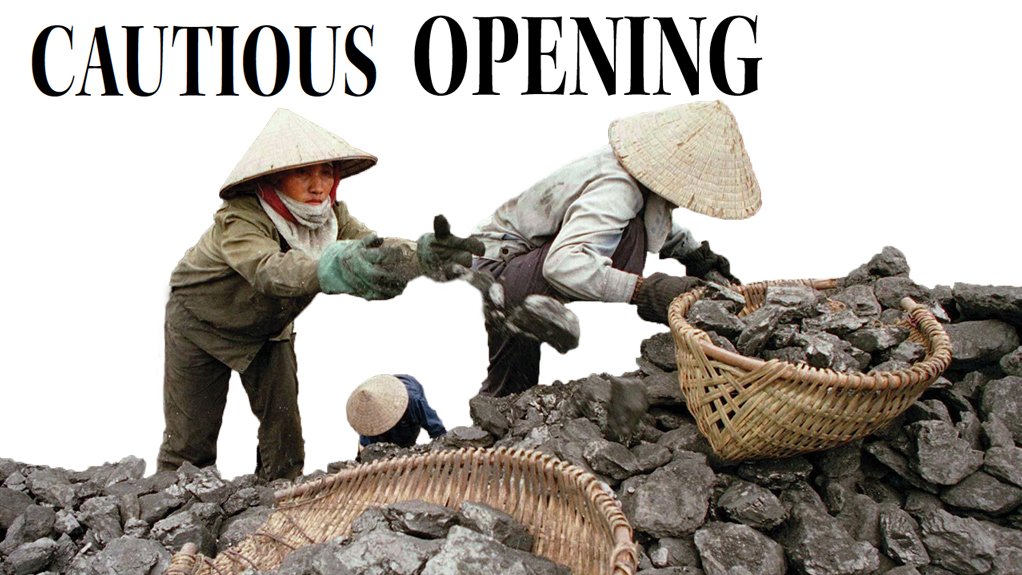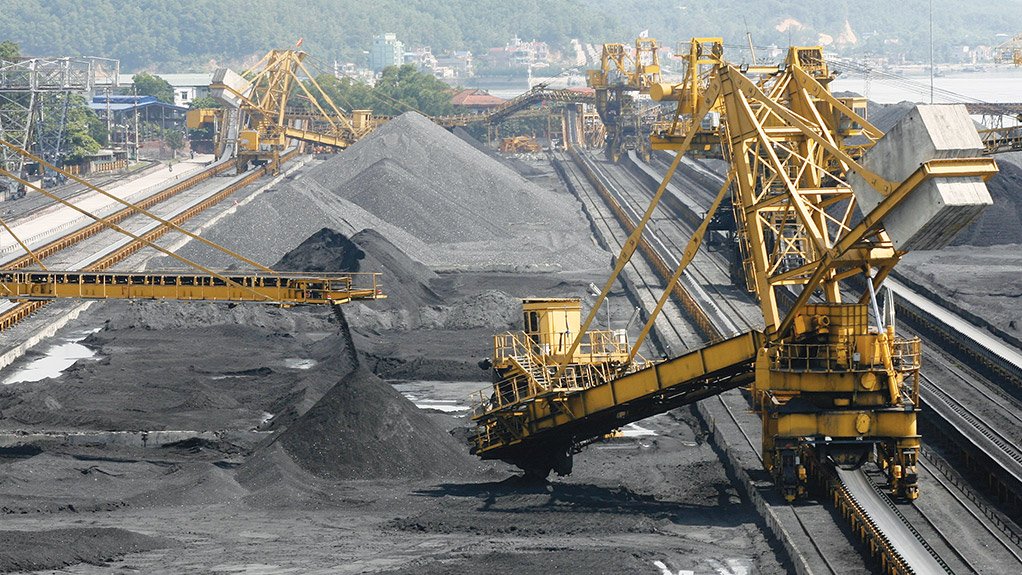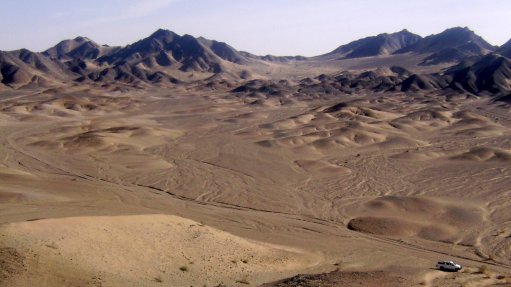Vietnam more welcoming to foreign miners, but constraints remain




PREPARING FOR EXPORT Anthracite is stacked at the Cua Ong Coal Preparation Company, at Cam Pha, in Quang Ninh province, north-east Vietnam
DOWNSIZING The coal preparation plant at the Coc 6 opencast coal mine, at Cam Pha, in Quang Ninh province. The number of opencast coal mines in Vietnam will be significantly reduced by 2030
March saw the holding of the second ever international mining and minerals conference in Vietnam. Held at the International Centre for Exhibitions in the capital city of Hanoi, Mining Vietnam 2014 was attended by 3 581 trade delegates from 30 countries. This figure included 1 089 company CEOs, chairpersons, directors, GMs and/or owners. No fewer than 169 companies, also from 30 countries, exhibited at the conference. Six countries – Australia, China, the Czech Republic, Germany, Poland and the UK – had pavilions in the exhibition. South Africa was also represented at the show, as were Austria, Belgium, Canada, France, India, Indonesia, Ireland, Israel, Italy, Japan, (South) Korea, Laos, Malaysia, Myanmar, the Philippines, Russia, Saudi Arabia, Singapore, Taiwan, Ukraine, the United Arab Emirates and the US, while Vietnamese companies naturally attended as well.
Mining Vietnam is now set to be a biennial feature (its first iteration was in 2012) on the global mining conference and exhibition circuit. Its creation and continuation are symptomatic of Vietnam’s emergence as an increasingly prospec- tive country for the global mining industry.
Reforms and Resources
Of course, mining is not new to Vietnam. Coal, for example, has been mined in the north of the country for more than 170 years. But, for decades, the sector was not very accessible to outsiders, owing to three decades of war (1946 to 1975), including two decades of partition (1954 to 1975), marked by strictly orthodox communist economic policies in the pre-1975 North Vietnam and in the post-1975 unified country. But, in 1986, things began to change. In that year, an economic reform programme, known as Doi Moi, was started to convert the communist economy into a ‘socialist oriented market economy’, simi- lar, although not identical to, China’s ‘socialist market economy’ (there has, to date, been proportionately less privatisation in Vietnam than has taken place in China).
The World Bank has hailed Doi Moi as a success. The global institution reported that the country’s per capita income, less than $100 in 1986, was $1 130 at the end of 2010. The proportion of the people living in poverty fell dramatically from 58% in 1993 to 14.5% in 2008. Vietnam doubled its electricity generation capacity from 12 000 MW in 2005 to 25 000 MW in 2010 and 95% of the population are now connected to the grid. Urban water supply doubled in small towns between 2006 and 2009, reaching a proportion of 60% in the latter year. Over the same period, in the cities, the figure rose from 75% to 95%. In rural areas, access to clean water increased from 36% in 1999 to 70% in 2009. Some 80% of urban dwellings now have sanitation, although most still use septic tanks. More than 90% of the population are now linked by all-weather roads. The proportion of children attending primary school full-time has jumped from 25% in 2005 to 50% today, while 77% of boys and 78% of girls now attend secondary school.
According to the International Monetary Fund, the Vietnamese economy grew by 5.4% in 2009, 6.4% in 2010, 6.2% in 2011, 5.25% in 2012, 5.4% in 2013 and is forecast to grow by 5.6% this year and 5.7% next year. Foreign direct investment inflows are expected to remain strong this year and next.
At the eleventh congress of the Communist Party of Vietnam, held in January 2011, while the country’s approach of State-led development was reaffirmed, key policy documents were revised to increase the emphasis on private-sector activities – “market processes and non-State ownership of economic assets,” in the words of the World Bank’s Vietnam Overview. This also notes that the country’s Socio-Economic Development Strategy for the period 2011 to 2020 “gives attention to structural reforms, environmental sustainability, social equity and emerging issues of macroeconomic stability”. The Strategy identified three “breakthrough areas”: improving human capital devel- opment, “improving market institutions” and developing infrastructure. “More recently, the conclusions of the October 2011 Communist Party plenum recognised the need for economic restructuring and identified restructuring of public investment, of [State-owned enterprises] and the financial sector, as priorities for the next five years.”
According the US Geological Survey’s (USGS’s) 2011 Minerals Yearbook, in that year, Vietnam produced the following metals – antimony (ore), bauxite, chromium (ore), copper (refined), gold, iron (and steel), lead, manganese, pyrites, tin, zinc and zirconium. The country also produced coal, gas and petroleum. Its industrial minerals output was made up of barite, cement (hydraulic), clays and kaolin, fluorspar, graphite, gypsum, lime, nitrogen, phosphate rock, pyrophyllite, salt, sand and gravel, silica sand, stone (building) and sulphur. In addition, bentonite, clay (refractory) construction aggregates, gem- stones, granite, lignite, marble, rare earths, silver and tungsten were produced “but not reported” (in the USGS’s words).
The quantities involved varied hugely. At the low end, antimony ore production in 2011 was 717 t, refined copper output was 8 000 t, lead production 7 400 t and smelted tin output was 3 000 t, for example. Pretty much at the other extreme, coal production was 44 494 000 t. (Only the country’s production of hydraulic cement was greater, at 58 994 000 t.) Vietnam was also the seventh-largest producer of petro- leum in the Asia-Pacific region.
The Australian Trade Commis- sion (Austrade) has reported mineral resources statistics sourced from Vietnam’s Ministry of Industry and Trade. These give the country’s apatite resources as 2.5-billion tons, bauxite resources as 10-billion tons, coal resources as 240-billion tons, mineral construction materials resources as 52-billion cubic metres, oil and gas resources as 1.2-billion cubic metres to 1.7-billion cubic metres, and rare earths resources as 11-million tons. “With the exception of coal, bauxite and titanium, most deposits discovered to date have been found to be too small to be economically viable for most international companies,” notes Austrade. “Other than for oil, coal, iron, titanium and apatite, mineral exploration activities have been limited to the basic survey stage.”
Constraints and Concerns
In his address to Mining Vietnam 2014, Deputy Industry and Trade Minister Le Duong Quang reported that mining was responsible for between 11% and 15% of the country’s gross domestic product. “However,” he cautioned, “Vietnam’s mineral potential is limited, thus requiring conservation and effectiveness in exploitation, while ensuring environmental protection.”
These concerns regarding limited resources and environmental protection help explain the constraints that weigh on the mining sector. Hanoi adopted a new Law on Minerals in 2010, followed by the issuing of Decree 15/2012/ND-CP in March 2012 (with effect from late April 2012) to provide guidance for the implementation of the law. In between, the country also adopted, in December 2011, a new Minerals Strategy for the period 2011 to 2020.
The objectives of the Minerals Strategy are to economically, effectively and sustainably manage, protect and exploit minerals in line with the country’s modernisation and industrialisation and to establish a minerals processing industry producing high-value-added products using modern technology. The strategy includes the prioritisation of geological surveys both under land and undersea, the development of international cooperation to obtain and use the latest scientific and technological methods for surveying, exploring, mining and processing, and a ban the export of raw minerals by 2020 (exporting higher-value processed minerals instead).
In consequence, exploration and mining licences for copper, gold, lead and zinc will only be issued on condition that such projects include the establishment of processing and refining plants in Vietnam, the use of modern technology and adherence to modern environmental standards. No new licences will be issued for placer gold. The export of apatite, chromite, copper concentrate, iron-ore, lead-zinc ore and manganese concentrate, as well as massive granite and massive white marble, has been banned (although, in some cases, at least regarding iron-ore, already operating mines have been granted exemptions). The export of coal, rare earths and “deeply processed” titanium ore must be approved by the Prime Minister.
On the other hand, most mining areas must now be concessioned through public auctions. Exceptions are areas in the designated border zone (for reasons of national defence and security), areas which have been assigned to other uses or where exploration and mining are restricted and areas containing minerals of strategic importance to the country. These strategic minerals include energy sources such as coal, thorium and uranium, as well as minerals used in cement production, such as limestone and clay, minerals used in construction materials which are to be used in the maintenance and repair of technical infrastructure. Other areas exempted from public auctions are those for which exploration and mining licences were granted before July 1, 2011, and those which contain minerals identified as feedstocks for already approved processing, refining and value-added manufacturing projects. In exceptional cases, the Prime Minister can decide that an area not be subject to public auction. (Investors can apply to the Prime Minister for such an exemption.)
When more than one company applies for an exploration licence in an area not subject to public auction, the law lays down the procedures to determine which investor is awarded the licence. Regardless of the type of area, miners now need only two licences to operate – exploration and mining – although they must also obtain the necessary environmental approvals. (Environmental protection and the honest application of mining laws and regulations have emerged as major concerns in Vietnamese civil society and in local communities.)
Miners, Local and Foreign
Currently, the Vietnamese mining sector is dominated by the State-owned Vietnam Coal & Minerals Industries Corporation (Vinacomin), which is divided into two divisions – coal and minerals. Austrade identifies another State-owned company involved in mining – the Vietnam Chemical National Corporation (acronymed to Vinachem), which has phosphate rock operations in Vietnam and rock salt operations in neighbouring Laos.
Vinacomin was created in 2005 by the merging of the Vietnam Coal Corporation and the Vietnam Mineral Corporation. It is responsible for about 95% of the country’s coal production, operating 54 mines, of which 30 are underground. Over the period from 2011 to 2030, the group will close 19 opencast operations, and the production share of its underground coal mines should rise from 45% in 2011 to 60% in 2015 to 80% in 2030. Over the period 2015 to 2025, Vinacomin plans to establish 19 underground mines with a total production capacity of 31-million tons a year (Mt/y). By 2030, the group plans to have an annual production capacity of between 65-million tons and 75-million tons.
Vietnam’s coal is of high quality, being mostly anthracite and semi-anthracite. About 25% of annual production is exported, most of these exports being anthracite. The export markets are China, Japan, Korea, Thailand and, outside Asia, Europe and Brazil. Domestically, coal is used for electricity generation and industrial uses (including the production of cement, chemicals, construction materials and fertiliser). About 60% of the domestic consumption is anthracite for power generation.
Vinacomin also produces, or is planning to produce, alumina, chromite, copper, iron-ore and zinc. Not all the group’s operations are entirely State-owned – Vinacomin has entered into a number of joint ventures with foreign companies. One of these partners is Alcoa World Alumina, which is cooperating with the Vietnamese group in the Gia Nghia bauxite mine and alumina refinery project in Dak Nong province. This will have a Phase 1 production capacity of between 1 Mt/y and 1.5 Mt/y.
In addition, Vinacomin is an importer of mining equipment and services. “Purchase of heavy mining equipment from Australia has enabled the expansion of existing, and development of new, underground mines,” points out Austrade. Further, the Vietnamese government has accelerated a programme to improve the technologies used in the mining and minerals sector. The aim is to match regional standards by next year and international standards by 2025.
While the country’s mining sector remains dominated by State-owned operations, thanks to Doi Moi, it is no longer 100% State-owned. The number of companies extracting minerals in Vietnam has rocketed from 427 in 2000 to almost 1 400 today, of which some 1 200 are small and medium-size enterprises mining and quarrying for construction materials. Most of these are private-sector Vietnamese enterprises.
Foreign private-sector miners now active in Vietnam include Atlantic (of Australia), with the Bao Luc bauxite project; Asian Mineral Resources (a Canadian enterprise), with the Ban Phuc nickel project; Axiom Mining (also Australian, and active in both Vietnam and Laos), with various gold prospects (Quang Tri, Me Xi, Xa Loi and Khe Fia) and the Quang Binh gold project, Besra Gold (Canadian), with the Bong Mieu gold project; and Triple Plate Junction (of the UK), which is exploring for gold.
Austrade lists other “notable private, [presumably Vietnamese-owned], and foreign mining operations and projects” as being the Nui Phao tungsten mine and processing plant, the Phouc Son gold mine, the Cao Bang manganese mine and the Binh Phuoc bauxite project. In addition, there are “[m]any private mineral sands mines along the coast in the south of Vietnam” and “limestone and marble mines” as well as other producers of construction materials.
Comments
Press Office
Announcements
What's On
Subscribe to improve your user experience...
Option 1 (equivalent of R125 a month):
Receive a weekly copy of Creamer Media's Engineering News & Mining Weekly magazine
(print copy for those in South Africa and e-magazine for those outside of South Africa)
Receive daily email newsletters
Access to full search results
Access archive of magazine back copies
Access to Projects in Progress
Access to ONE Research Report of your choice in PDF format
Option 2 (equivalent of R375 a month):
All benefits from Option 1
PLUS
Access to Creamer Media's Research Channel Africa for ALL Research Reports, in PDF format, on various industrial and mining sectors
including Electricity; Water; Energy Transition; Hydrogen; Roads, Rail and Ports; Coal; Gold; Platinum; Battery Metals; etc.
Already a subscriber?
Forgotten your password?
Receive weekly copy of Creamer Media's Engineering News & Mining Weekly magazine (print copy for those in South Africa and e-magazine for those outside of South Africa)
➕
Recieve daily email newsletters
➕
Access to full search results
➕
Access archive of magazine back copies
➕
Access to Projects in Progress
➕
Access to ONE Research Report of your choice in PDF format
RESEARCH CHANNEL AFRICA
R4500 (equivalent of R375 a month)
SUBSCRIBEAll benefits from Option 1
➕
Access to Creamer Media's Research Channel Africa for ALL Research Reports on various industrial and mining sectors, in PDF format, including on:
Electricity
➕
Water
➕
Energy Transition
➕
Hydrogen
➕
Roads, Rail and Ports
➕
Coal
➕
Gold
➕
Platinum
➕
Battery Metals
➕
etc.
Receive all benefits from Option 1 or Option 2 delivered to numerous people at your company
➕
Multiple User names and Passwords for simultaneous log-ins
➕
Intranet integration access to all in your organisation





















